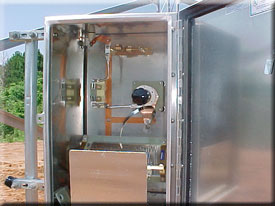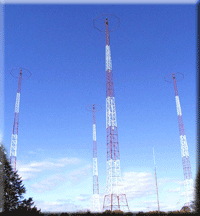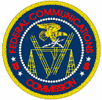
Product Information
AM Detuning
A golden rule during the halcyon capital spending days of the 1990s dictated that every communications structure built within 3.0 Km (1.9 miles) of an AM broadcast station required an extensive and expensive AM detuning analysis. The analysis may require an extensive detuning network and the engineering required to ensure that the licensee is in Federal Communications Commission compliance by not impacting the station’s signal strength established for the AM broadcaster.
The FCC rules clearly state that no detuning is necessary unless the tower affects an AM station and there are many sites that will not require action by the licensee to be compliant. If the proposed structure has the potential to absorb or reflect (reradiate) the AM station’s signal, detuning will most likely be required.
Detuning requirements are dependent upon whether the AM station is directional or non-directional. Non-directional stations, approximately half of all stations, use the entire guyed tower as the antenna. If the station is directional, controlled RF signals are radiated among multiple towers, allowing the station to limit or increase signal strength where needed to achieve the proper radiated pattern.
We recommend that you contact our valued AM Detuning professionals for your site-specific requirements.
Pricing variables require supplier quotations

Since there are many variables that must be considered in evaluating a proposed tower, it is suggested that you contact a reputable firm with a proven record in the industry for a quotation. Some towers may have more of an impact upon the existing AM station as a result of their height, type and proximity to the station and the station’s operating frequency. Depending upon the number of measurements performed, the structure’s location and the complexities of the system, your product and consulting costs can range from $500 for a compliance consultation to as high as $20,000 for an installed network. In preparing a capital expense budget or providing a proposal to engineer, furnish and install a detuning system, don’t use a previous project’s costs as a baseline price. Chances are the project requirements are not the same although they might appear similar.
If you are the turnkey contractor for a guyed tower that is being detuned, add the additional costs for the installation and purchase of insulators when the guy wire must be broken up into suitable electrical lengths. Sometimes it becomes necessary to use Phillystran or other non-metallic guy wires.
Why is detuning required and how is it done?
If you construct any type of structure (monopole, water tank, guyed and self supporting tower) near an AM broadcast station it has the potential to reradiate the station’s broadcast pattern. This activity is similar to placing two tuning forks next to each other. Strike one and the sister fork will begin to vibrate as well.
 Detuning is most easily accomplished by mounting "skirt wires" on the new structure. These copper or stainless steel wires will also pick up energy from the AM station(s). A coil and capacitor at the end of the skirt housed in a waterproof box at the base of the tower is used to adjust the phase of the energy in the wires, canceling or reducing the amount of reradiated energy. Detuning is most easily accomplished by mounting "skirt wires" on the new structure. These copper or stainless steel wires will also pick up energy from the AM station(s). A coil and capacitor at the end of the skirt housed in a waterproof box at the base of the tower is used to adjust the phase of the energy in the wires, canceling or reducing the amount of reradiated energy.
Some structures must be detuned for more than one AM station. This can be done by installing additional wire skirts, each with its own tuning circuit.
However, prior to and following the detuning system’s installation, AM radiation pattern measurements must be made by the contracting firm to ensure that the AM station remains in compliance with its FCC radiation parameters.
How can I locate AM stations near a tower site?
This FCC link will provide you with the ability to search for AM towers near your proposed tower site. However, if there is an error within the database, it will not absolve you from any actions brought by an effected station. You'll need to provide the site's latitude and longitude.
Do modifications on a detuned tower affect it?
Retrofitting or adding lines, mounts, antennas, platforms and accessories will affect the amount of re-radiation by the structure, but it typically provides a minimal impact. As long as the overall height of the structure remains the same, there is little likelihood of an AM pattern influence. The FCC’s 47CFR22.371 also requires that the tower owner must provide for continued maintenance of any required detuning hardware.
What FCC rule governs AM Detuning?
47CFR22.371 Part 22 applies to cellular carriers, but many Part 24 PCS carriers have adopted Part 22 as well.
47CFR22.371 Part 22 - Public Mobile Services
Subpart C - Operational and Technical Requirements
Section 22.371 Disturbance of AM broadcast station antenna patterns.
Public Mobile Service licensees that construct or modify towers in the immediate vicinity of AM broadcast stations are responsible for measures necessary to correct disturbance of the AM station antenna pattern which causes operation outside of the radiation parameters specified by the FCC for the AM station, if the disturbance occurred as a result of such construction or modification.
a) Non-directional AM stations. If tower construction or modification is planned within 1 kilometer (0.6 mile) of a non-directional AM broadcast station tower, the Public Mobile Service licensee must notify the licensee of the AM broadcast station in advance of the planned construction or modification. Measurements must be made to determine whether the construction or modification affected the AM station antenna pattern. The Public Mobile Service licensee is responsible for the installation and continued maintenance of any detuning apparatus necessary to restore proper non-directional performance of the AM station tower.
b) Directional AM stations. If tower construction or modification is planned within 3 kilometers (1.9 miles) of a directional AM broadcast station array, the Public Mobile Service licensee must notify the licensee of the AM broadcast station in advance of the planned construction or modification. Measurements must be made to determine whether the construction or modification affected the AM station antenna pattern. The Public Mobile Service licensee is responsible for the installation and continued maintenance of any detuning apparatus necessary to restore proper performance of the AM station array.
|